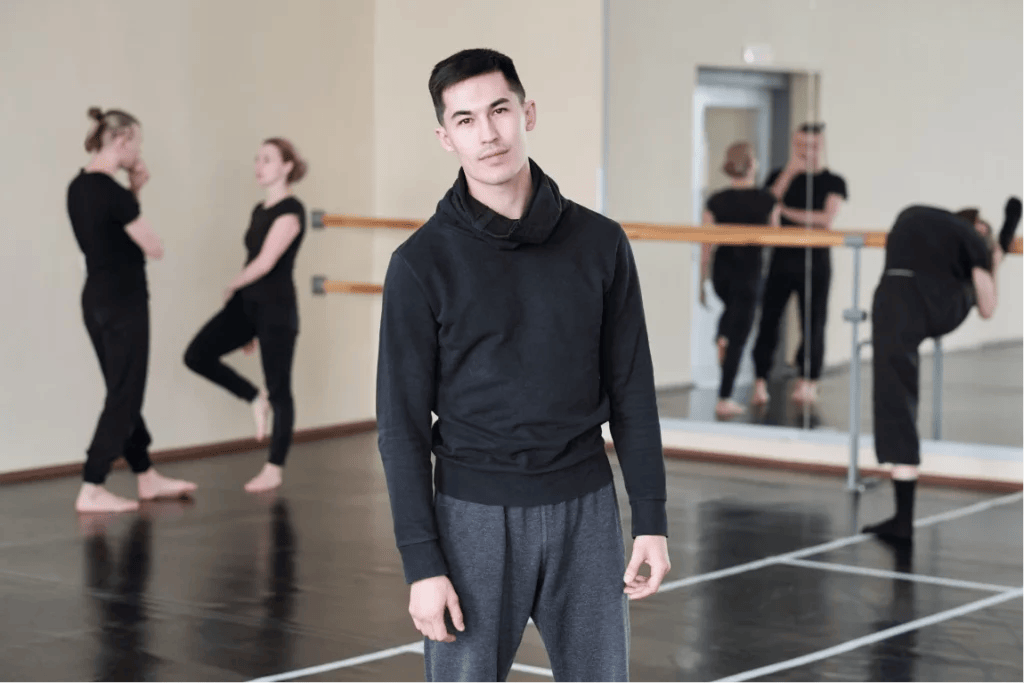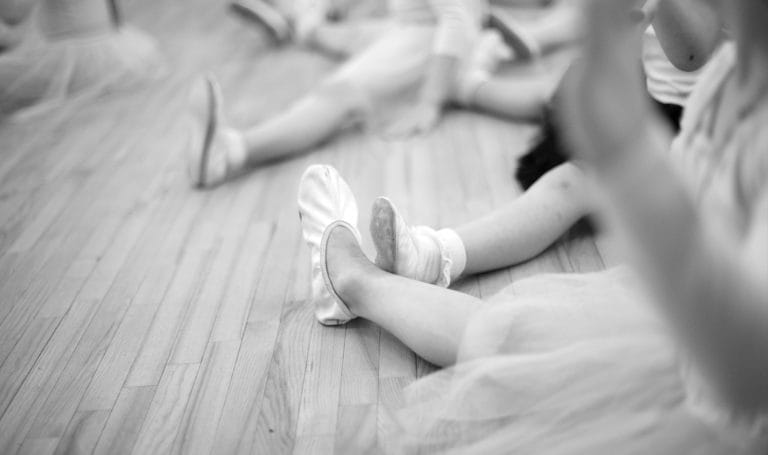- Last Updated:
- 11/27/2024
- Julis Navarro
So you think you can dance — and now you’re interested in taking the leap into teaching! But how to land that dream dance teacher job? Well, let’s start with a quick quiz.
When you envision yourself teaching your favorite dance style, where are you?
- A K-12 school
- A university
- A dance studio
- A fitness center
- Wherever I feel like that day
Depending on your answer, the path toward becoming a dance teacher will differ. Here are the main things to know about the general requirements of each type of instruction.
K-12 School
You typically need a bachelor’s degree and a state teaching license or certification.
College or University
You typically need at least a master’s degree in dance or dance education.
Dance Studio
You typically don’t need proof of formal education, but a dance certification will increase your chances of getting hired.
Fitness Center
You typically need a group fitness certification or a specific dance fitness certification (like Zumba) to get hired.
Freelance
You don’t need any specific education or certifications to start as a freelance dance teacher, but you will need experience and expertise to attract potential students.
Read on to start warming up for your career.
Start as a Dancer
If you’re excited about sharing dance knowledge with others, you likely are already a dancer. No matter where or who you decide to teach, you must have the foundation of dance education before you begin teaching.
That means you’ll need to have started as a dancer, whether as a student or as a professional performer. Mastering technique and expression can be grueling, so an innate love of dance is essential.
Still wondering if this is the right path for you? Here’s some advice Jessica Burkholder would have given to herself when she was just starting out: Trust your gut!
"It’s so important to believe in yourself and don’t forget your passions. When I was younger, I always wanted to work with kids and be a school teacher. But I also had this passion for dance and a passion for helping others. Plus I wanted to be a mom. Now I get the chance to have all of that!"
– Jessica Burkholder, Dance Instructor and Insurance Canopy policyholder
Choose Your Dance Style(s)
“Dance” is a broad term repping hundreds of styles — so becoming a dance teacher means deciding what dance style you want to teach. Ideally, the best style to teach would be the one you love the most, but you should also consider your skill level and the demand for that particular style.
When you’re just starting out as a dance teacher, it’s smart to specialize in one dance style, build your student base, and then expand to include other styles once you feel confident.
You may find that niching down and being the “go-to teacher for lyrical dance” in your area, for example, can set you apart from other instructors. On the other hand, you may attract more students by being a multi-style teacher they can go to to learn multiple dance forms.
Some popular dance styles to teach include:
- Ballet
- Jazz
- Modern
- Hip-hop
- Tap
- Contemporary
- Lyrical
- Ballroom
- Salsa
- Swing
- Tango
- K-pop
- Afrobeats
- Hula
- Tahitian
- Bollywood
- Bellydance
- Irish stepdance
- Breaking
- Heels
- House

Meet Dance Teacher Requirements for Education
If you’re itching to turn up the music and share an across-the-floor combo right now, the truth is you can start teaching dance today. The caveat is that if you want a position at an illustrious school or to receive a higher-than-average dance teacher salary, you may need to meet certain education requirements.
Even if formal education is not mandatory for the particular job you’re aiming for, having these credentials makes you more hirable. In other words, the more training you have, the easier it will be to become a dance teacher!
Dance Education
At the minimum, you should be educated in the style of dance you want to teach. So you’ll have taken classes within a structured program and are knowledgeable enough to demonstrate and instruct on the style.
These classes cover aspects like technique, body awareness, posture, choreography, musicality, and rhythm. The great news is that attending class as a student gives you a strong sense of how to structure your classes as a teacher in the future.
Required for: Teaching any dance class.
Bachelor’s Degree
A dance-focused bachelor’s degree takes about four years of full-time study to complete, and you have several options, including:
- Bachelor of Arts (BA) in Dance: Balanced education in both dance practice and theory
- Bachelor of Arts (BA) in Dance Education: Specifically designed for those who wish to teach dance; focus on dance technique and theory, plus pedagogy and curriculum development
- Bachelor of Fine Arts (BFA) in Dance: Tailored for dancers interested in performance (professional dancers, choreographers, etc.)
Required for: Teaching dance at most public K-12 schools.
State Teaching License
A state teaching license or certification grants you the ability to teach in public schools. To get a license, you’ll typically need a bachelor’s degree in dance education (or a related field).
You’ll also need to pass your state exam. The requirements vary by state, so be sure to check with your local jurisdiction for the most up-to-date guidelines.
Required for: Teaching dance at most public K-12 schools.
Master’s Degree
If you’re aiming to teach dance at the college level, you’ll need to earn a master’s degree in dance education or a related field.
These degrees specialize in areas like choreography, pedagogy, and dance therapy. They’re especially valuable if you are aspiring for an artistic or education director role (higher earning potential!).
Similar to the bachelor’s degrees in dance, some of your options for a master’s degree include:
- Master of Arts (MA) in Dance or Dance Education
- Master of Fine Arts (MFA) in Dance
- Master of Education (MED) in Dance
Required for: Teaching college-level dance.
Formal Training Programs
To hone your dance technique even further, you can enroll in a formal dance training program. These are available through dance conservatories and some colleges and offer intensive training, often with access to a professional network that can jumpstart your career.
Here are just a few:
- Alvin Ailey Training Programs (NY): Multiple programs offered by age group, including an independent study that can be applied as college credit
- Juilliard Dance Division Programs (NY): Summer dance intensive and one-day workshops available for high school-age dancers to experience Julliard’s dance program (a BFA in dance)
- Boston Conservatory at Berklee (MA): Commercial dance intensive exploring dance forms geared toward success in the entertainment industry
Not required, but recommended for: Giving yourself a strong dance foundation and boosting your professional appeal.
Dance teacher statistics for aspiring teachers:
- Dance teacher salaries have increased by 7% in the last 5 years.
- Dance teachers are most in demand in New York, NY.
- Overall employment of dancers and choreographers is projected to grow 6% from 2023 to 2033.
- One of the most popular dance studios (26.3 million subscribers) on YouTube is 1Million Dance Studio, a channel focused on K-pop choreography.
Get Real-World Experience
As you work toward gaining education credentials, now’s the time to get any practical teaching experience you can. You’ll feel more confident once it’s time to start applying for jobs, and the experience is highly attractive on your resume.
- Apply for internships or apprenticeships.
- Ask experienced teachers if you can shadow them during class.
- Volunteer or substitute at dance studios, schools, or community centers.
- Teach beginner classes or help as an assistant.
- Film short videos of yourself teaching and upload them on social media.
- Host a “friends and family” dance class to practice teaching.

Elevate Your Career With a Certification
Getting certified is like showcasing your signature move — it helps you stand out and gives you an advantage in the competitive teaching field.
You can generally think of a certification as a nice-to-have investment in your career. They vary greatly by dance style and certifying body, so be sure to research which certification aligns with your teaching goals.
Popular certifications:
- National Dance Education Organization (NDEO) Certificate in Dance Instruction
- Dance Educators of America (DEA) Advanced Teacher Certification
- American Dance Institute Dance Teacher Certification
- American Dance Therapy Association (ADTA) Dance/Movement Therapist Certification
- Royal Academy of Dance (RAD) Certificate in Dance Teaching (Ballet)
- Laban Bartenieff Institute of Movement Studies (LIMS) Certification
- Dance Masters of America (DMA) Membership
- Zumba Instructor Certification
Most require you to complete coursework, have a certain number of teaching hours, and then pass an exam or assessment to verify your competence as a teacher. Costs vary and can range from $200–$2,000 or higher.
Some certifications focus on very specific teaching styles, so they might take just a few days. Other more comprehensive certifications can require several years of study. Once certified, you’ll need to complete continuing education (CE) credits to maintain your certification status.
Build Your Dance Instruction Portfolio
You’re leveling up as a dance teacher — showcase how great you are by building your dance instruction portfolio! This will be a highlight reel of standout teaching moments, choreography, and student performances you’ll have on hand to show employers why they should hire you.
You can create a free website with builders like Wix or Squarespace. Include a video gallery where studio owners and creative directors can easily click through to see your stellar teaching in action.
Other options are to focus solely on uploading content to your dedicated social media accounts. If you can build a following by sharing your passion for dance online, these accounts can effectively act as your dance teacher portfolio.
Here’s a little inspiration from dance professional Kyle Hanagami, who began his career on YouTube and brings in millions of views on his videos!
Find a Dance Teacher Job
Finally, it’s time to start looking for a dance teacher job. The best place to start is where you’re most comfortable — the studio or school where you trained. But if you’re ready to stretch your perfectly positioned wings, here are some tips.
- Network, network, network. Lean into your dance community of friends and teachers to find open positions they can recommend you for.
- Look for jobs at studios, schools, gyms, recreation centers, community centers, youth centers — anywhere you can think of with groups of people who could benefit from dance classes.
- Build your personal brand (especially on social media); if you can show employers how much of a draw your classes can bring, that’ll increase your chances of getting hired.
- Check online job postings regularly and keep your resume updated with any shiny new credentials.
- Attend conferences like the NDEO National Conference or the NDCA Conference and be on the lookout for job opportunities as you meet new people in the industry.
Protect Your Dance Career
Accidents happen in the dance studio, on the stage, and beyond.
Have you ever accidentally pirouetted into another dancer? Or slipped on a puddle of water in the reception area? Sometimes you just land wrong on your ankle.
When you’re teaching dance, you’ll be taking care to ensure your students are safe and employing proper technique.
But some things are out of your control — if your students get hurt, have their property damaged, or even if they blame you for not teaching them correctly, you can be held responsible for paying to make things right.
Dance teacher liability insurance is designed to financially protect you against common claims associated with your work. It’s essential for keeping your budding dance career safe for years to come.

Expand Your Student Base
Congrats! It’s going to feel so rewarding to finally say, “I’m a dance teacher!”
You may want to start slow, by teaching just a class or two to build confidence. But soon you might find you’re ready for more students. This will be an ongoing endeavor, but with some marketing magic and consistency, you can begin to grow your student roster.
FAQs About How to Be a Dance Teacher
How Much Does a Dance Teacher Make?
Dance teachers in the US make about $25/hour, but some of your peers are reporting wages as high as $43.99/hour! How much you make will largely depend on your location, your skill level, and years of experience.
What Are Typical Dance Teacher Responsibilities?
Dance teacher duties include planning lessons, instructing students in various techniques, and providing constructive feedback. You might also choreograph and prepare students for performances.
Your main responsibility as a dance teacher is to foster a safe, supportive learning environment where students can discover dance as an art form and a sport.





